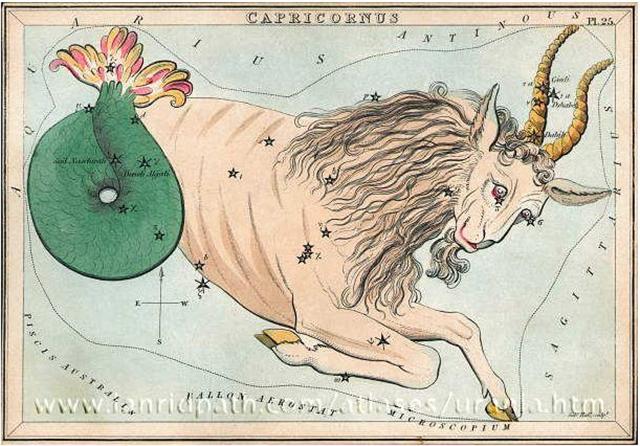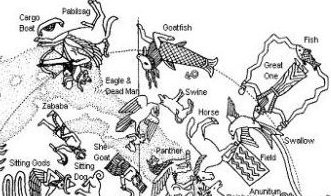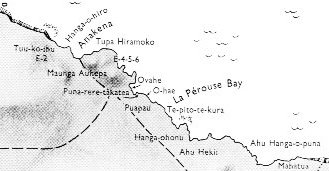The 24 + 1 (i) Aquila stars, which were beginning with ε at the peculiar balancing bird in Cb11-9, are stretching up to ρ (Tso Ke, the Left Flag) on the border (drawn by modern man) to the Dolphin constellation in January 21, and a greater kahi (also this one though referred to as simply ika by Metoro) arrived 8 nights after kahi in January 10:
Possibly the midnight culminations of Antares followed 9 nights later by that of Betelgeuze was important for the calendar makers.
Heliacal Gredi (α Capricorni) could have motivated the reversed figure in Cb12-7.
In the Babylonian zodiac the Goatfish was a constellation which continued the normal path straight ahead instead of following the Milky Way upwards:
Metoro may have wished Bishop Jaussen should count (hia) from vai o ako hia to vai o maro hia, a stretch of time from January 1 to January 20. Then, in January 21 would come the Left Flag, possibly indicating the border where Aquila (the royal residence?) ended. ... Nuku Keku was ... in charge of the feather garlands (maro), which served to mark the boundaries of the royal residence. He had pounded (the staffs with the feather garlands) into the ground. The middle (te tini) was located in front of the bay of Hanga Rua. The feather garlands went up, continued, and reached Puku Parari. They went up again and reached Puku O Heha. From Puku O Heha they formed (a line) to the side, to Aro Huri. From Aro Huri they turned again toward the sea and reached Maunga Koua, went down, went their way, and reached Hira Moko. (He) made a second line (? he rua taupa) of feather garlands ... Hanga Rua is a misprint in the translation of Barthel. I suspected it couldn't be a '2nd Bay', because that must be at the end and not in the middle. Perhaps it was a misprint I guessed. And I was right, because according to the original Polynesian version the bay is Hanga Rau (the Bay of Leaves, meaning multiple offspring I think):
Tupa Hiramoko is the cape east of Anakena, presumably the same place as referred to by the 6th and last name mentioned (Hira Moko). The other names cannot be found on my maps. But we know where Hanga Rau is located, that is where the canoe of Hotu Matua (and also the canoe of Ava Rei Pua) anchoraged, just outside Anakena: ... When Hotu's canoe had reached Taharoa, the vaginal fluid (of Hotu's pregnant wife) appeared. They sailed towards Hanga Hoonu, where the mucus (kovare seems to refer to the amniotic sac in this case) appeared. They sailed on and came to Rangi Meamea, where the amniotic fluid ran out and the conctractions began. They anchored the canoe in the front part of the bay, in Hanga Rau. The canoe of Ava Rei Pua also arrived and anchoraged. After Hotu's canoe had anchoraged, the child of Vakai and Hotu appeared. It was Tuu Maheke, son of Hotu, a boy ... (Manuscript E, p. 80) A connection between staffs (uprights) and land (horizontal) was probably thought of as mediated by 'fire' (feathers) ...
| |||||||||||||||||||||||||||||||||||||||||||||||||||||||||||||||||||||||||||||||||||||||||||||||||||||||||||||||||||||||||||||||









